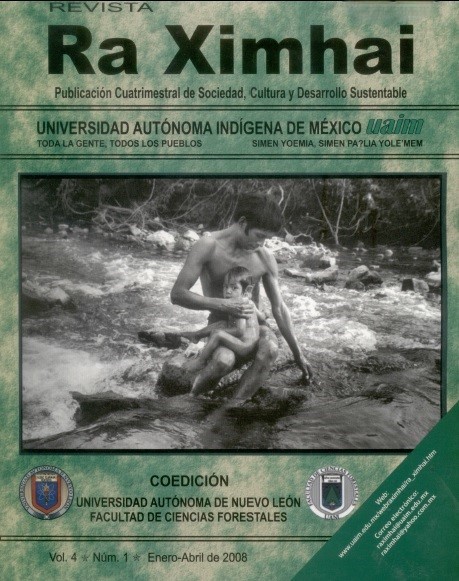Location and uses of wild grapevines (Vitis spp.) in the state of Puebla, Mexico
DOI:
https://doi.org/10.35197/rx.04.01.2008.09.omKeywords:
collection, georeferentiation, germplasm gardens, natural resources, wild grapevineAbstract
In Mexico, the correct location of wild vines (Vitis spp.) as well as the current uses by the population are not fully documented. In recent years, in the state of Puebla, more than 180 sites where vines were located were located; the most important in their geographic location belong to three regions of the state, Teziutlán, Atlixco and Tehuacán, with 113, 46 and 24 sites, respectively. Plants were found from 120 (Hueytamalco) to 2540 (Chiautzingo) meters above sea level (masl) developing in humid environments or on the sides of runoff, rivers or canals, in regions with a dry climate. In Chapulco, Nealtican and Izúcar de Matamoros, the fresh berries are consumed; in Atempan, they are prepared in jam; and in Coxcatlán, the infusion of leaves is recommended for heart ailments. In Tlatlauquitepec, there is knowledge that wild vines can serve as rootstocks for commercial cultivars. The accessions are deposited in the Vitis germplasm banks of the Autonomous University of the State of Mexico (Toluca, Mexico), the Autonomous University of Chapingo (Huatusco, Veracruz) and the Benemérita Autonomous University of Puebla (Teziutlán, Puebla).
Downloads
References
––––Anónimo. 1973. Vides nativas de México. Comisión Nacional de Fruticultura.
Xalapa, Ver. 63 p.
Asencio, M. L., E. Valdés y F. Cabello. 2002. Characterisation of some Spanish white grapevine cutivars by morphology and amino acid analysis. Scientia Horticulturae 93: 289-299.
Camargo, U. A. 2000. Grape breeding for the subtropical and tropical regions of Brazil. Acta Horticulturae 528: 473-477.
Boursiquot, J. M. 2000. Development of methods for the conservation and the management of grape genetic resources. Acta Horticulturae 528: 33-38.
Cruz, C. J. G. 2007. Las uvas (Vitis) silvestres: distribución y usos en la región central de Veracruz. In: R. Nieto A. (Ed.) Frutales nativos, un recurso fitogenético de México. Universidad Autónoma Chapingo. Chapingo, México. pp. 225-235.
Cruz, C. J. G., J. A. Ortíz P., A. Roque P., O. Franco M., J. Madero T., J. P. Cirigiliano y J. Murguía. 2006. Las uvas (Vitis) silvestres, distribución y usos en la región central de Veracruz. Aquí centros regionales. 48: 3-6.
Franco-Mora, O., A. A. Cortés-Sánchez, A. C. Rodríguez-Landero, J. G. Cruz-Castillo, J.
M. Pérez and J. Madero-Tamargo. 2007. Location of wild grapevine (Vitis spp) in the state of Puebla, México. HortScience 42: 1008. (abstract)
INAFED. 2005. Enciclopedia de los municipios de México. Secretaria de Gobernación. Disponible en http://www.e-local.gob.mx/wb2/ELOCAL/ELOC_Enciclopedia. (Consultado 03/01/2008).
INEGI. 2006. Síntesis geográfica digital de Estado de Puebla. Anexo cartográfico digital.
Dirección General de Cartografía.
Laguna, L. E. 2004. Datos foliares de las especies e híbridos alóctonos de vides (Género
Vitis) en el territorio valenciano. Toll Negre 3: 11-25.
López, S. J. A. 2001. Estudio florístico de la parte central de la barranca Nenetzingo, Municipio de Ixtapan de la Sal, Estado de México. Tesis M. C. Colegio de Postgraduados. Montecillo, México. 100 p.
Lu, M. C. 2005. Micropropagation of Vitis thunbergii Screb. et Zucc., a medical herb, trough high-frecuency shoot tip culture. Scientia Horticulturae 107: 64-69.
Luna G. G. 2007. Distribución ecogeográfica y aprovechamiento de uva silvestre (Vitis spp.) en la región totonaca de Puebla. Tesis de Lic. Universidad Autónoma Chapingo. Huatusco, Veracruz. 84 p.
Martínez M. A., V. Evangelista, F. Basurto, M. Mendoza y A. Cruz-Rivas. 2007. Flora útil de los cafetales en la Sierra Norte de Puebla, México. Revista Mexicana de Biodiversidad 78: 15-40.
Ocete, R., M. A. López, M. Lara and R. Del Tío. 1997. The sanitary state of a phytogenetic resource: the Spanish wild grapevine, Vitis vinifera sylvestris Gmelin (Hegi), populations. Plant Genetic Resources Newsletter (FAO) 110: 5-12.
Ocete, R., M. A. López, A. Gallardo C., C. Arnold, M. A. Pérez I. y I. M. Rubio. 2004. La vid silvestre en el País Vasco y territorios limítrofes: ecología, distribución y riesgos para su conservación. Servicio Central de Publicaciones del Gobierno Vasco. Donostia, San Sebastián. 179 p.
Omer A. D., J. Granett y C. W. Shebelut. 1999. Effect of attack intensity on host utilization in grape phylloxera. Crop Protection 18: 341-347.
Rzendowski, J. y G. Calderón R. 2005. Flora del Bajío y de regiones adyacentes.
Fascículo 131. Vitacea. Instituto de Ecología. Patzcuaro, Michoacán. 31 p.
Samson, J. A. 1991. Fruticultura tropical. Limusa. México, D. F. 396 p.
Schmid, J., F. Manty y E. H Rühl. 2003. Utilizing the complete phylloxera resistance of
Vitis cinerea Arnold in rootstock breeding. Acta Horticulturae 603: 393-400.
Tobar, R. J. R., O. Franco M., J. M. Barrios D., M. Huerta L., E. Joaquín M. y P. Zaldivar
M. 2007. Conservación de vides (Vitis spp.) silvestres de Puebla y estudio de metabolitos secundarios. In: J. F. López O., A. Aragón G. y M. Tornero C. (Eds.) Avances en agroecología y ambiente. Vol. I. Benemérita Universidad Autónoma del Puebla. Puebla, México (En prensa).
Downloads
Published
How to Cite
Issue
Section
License
Copyright (c) 2008 Omar Franco Mora, Juan Guillermo Cruz Castillo, Adriana Aurora Cortés Sánchez , Ana del Carmen Rodríguez Landero

This work is licensed under a Creative Commons Attribution-NonCommercial 4.0 International License.
Usted es libre de:
- Compartir — copiar y redistribuir el material en cualquier medio o formato
- Adaptar — remezclar, transformar y construir a partir del material
- La licenciante no puede revocar estas libertades en tanto usted siga los términos de la licencia
Bajo los siguientes términos:
- Atribución — Usted debe dar crédito de manera adecuada , brindar un enlace a la licencia, e indicar si se han realizado cambios . Puede hacerlo en cualquier forma razonable, pero no de forma tal que sugiera que usted o su uso tienen el apoyo de la licenciante.
- NoComercial — Usted no puede hacer uso del material con propósitos comerciales .
- No hay restricciones adicionales — No puede aplicar términos legales ni medidas tecnológicas que restrinjan legalmente a otras a hacer cualquier uso permitido por la licencia.








